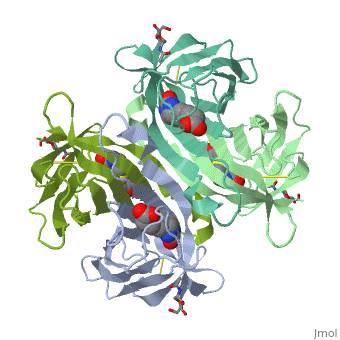User:Noam Gonen/Avidin
From Proteopedia
< User:Noam Gonen(Difference between revisions)
(Undo revision 2348624 by Noam Gonen (Talk)) |
|||
| (One intermediate revision not shown.) | |||
| Line 5: | Line 5: | ||
== Structure == | == Structure == | ||
| - | The tetrameric protein contains four identical subunits (homotetramer), each of which can bind to biotin (Vitamin B7, vitamin H) with a high degree of affinity and specificity. The dissociation constant of avidin is measured to be KD ≈ 10−15M, making it one of the strongest known non-covalent bonds[2].The overall fold of the avidin monomer is constructed of eight antiparallel β-strands which form classical | + | The tetrameric protein contains four identical subunits (homotetramer), each of which can bind to biotin (Vitamin B7, vitamin H) with a high degree of affinity and specificity. The dissociation constant of avidin is measured to be KD ≈ 10−15M, making it one of the strongest known non-covalent bonds[2].The overall fold of the avidin monomer is constructed of eight antiparallel β-strands which form classical <scene name='Sandbox-test/Avidin_b-barrels/1'>beta-barrel</scene>. |
== Monomer- monomer interaction == | == Monomer- monomer interaction == | ||
'''Interaction 1-2''' | '''Interaction 1-2''' | ||
| - | Monomers are linked by hydrogen bond interactions between the respective N-terminal portions of β8-strands of each monomer. The β8-strands form a short antiparallel β-sheet. Each monomer contributes Trp-110 to its partner as an additional and very significant component of the biotin-binding site. When biotin is bound, interaction 1-2 is enhanced greatly, owing to the Trp-110-biotin interaction. The buried surface area of interaction is〖729Å〗^2. | + | |
| + | Monomers are linked by hydrogen bond interactions between the respective N-terminal portions of β8-strands of each monomer. The β8-strands form a short antiparallel β-sheet. Each monomer contributes Trp-110 to its partner as an additional and very significant component of the biotin-binding site. When biotin is bound, interaction 1-2 is enhanced greatly, owing to the Trp-110-biotin interaction. The buried surface area of interaction is〖729Å〗^2. | ||
'''Interaction 1-3''' | '''Interaction 1-3''' | ||
| Line 20: | Line 21: | ||
'''Hydrophobic residues in the binding site of avidin''' | '''Hydrophobic residues in the binding site of avidin''' | ||
| - | These include Trp-70, Phe-72, Phe-79, and Trp-97 from one monomer, and Trp-110 (dashed lines), which is provided by the adjacent symmetry-related monomer. | + | These include Trp-70, Phe-72, Phe-79, and Trp-97 from one monomer, and Trp-110 (dashed lines), which is provided by the adjacent symmetry-related monomer. |
| - | + | == Structural highlights == | |
| - | + | ||
| - | + | ||
| + | This is a sample scene created with SAT to <scene name="/12/3456/Sample/1">color</scene> by Group, and another to make <scene name="/12/3456/Sample/2">a transparent representation</scene> of the protein. You can make your own scenes on SAT starting from scratch or loading and editing one of these sample scenes. | ||
| + | </StructureSection> | ||
== References == | == References == | ||
<references/> | <references/> | ||
Current revision
INTRODUCTION
Avidin is a tetrameric or dimeric[1] biotin-binding protein produced in the oviducts of birds, reptiles and amphibians and deposited in the whites of their eggs.
| |||||||||||

